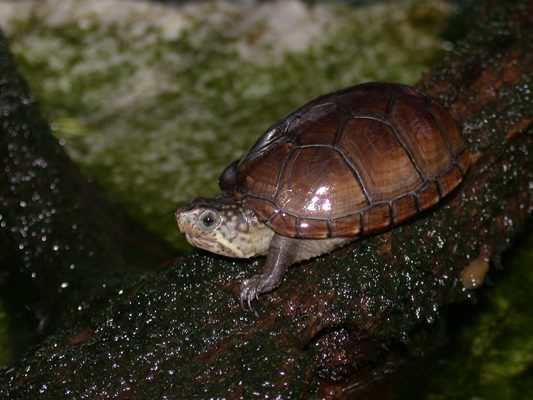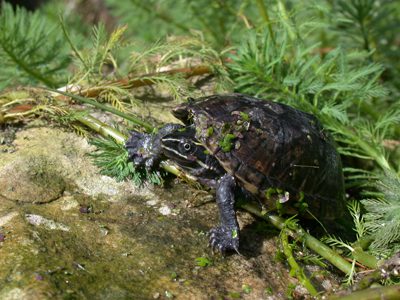Eastern mud turtles

While walking along the Rocky River one day in Stanly County, I came upon a neat little turtle on the stream banks who had suffered some kind of physical malady, from which he must have recovered a while ago. He had a slight disfigurement of his face, but he had healed nicely, so I placed him back safely on the sandy banks. Unsure what species it was, I took several pictures, and when back in the office checked it out.
He turned out to be an Eastern Mud Turtle (Kinosternon subrubrum) and he was about at the extent of his range westward in North Carolina. He was a small turtle with a dark brownish shell, and the plastron (or bottom of the shell) did not come anywhere near fully enclosing him, unlike some other turtles found in this region. Mud turtles grow to only about 5 inches or so long, and can live to be as old as 50 years or more.
 Although they are classified as aquatic turtles, they prefer shallow, slow streams and walk along the bottoms instead of swimming most of the time. They actually spend a lot of time out of the water, which is probably why I found this little guy on the streambank. They are closely related to the more aquatic musk turtles (Sternotherus odoratus), which are distinguishable from mud because musk have only one hinge on their plastron. Musk turtles, as you might guess, release a smelly musk when threatened, which has gained them the somewhat unfavorable nickname of “stinkpot.”
Although they are classified as aquatic turtles, they prefer shallow, slow streams and walk along the bottoms instead of swimming most of the time. They actually spend a lot of time out of the water, which is probably why I found this little guy on the streambank. They are closely related to the more aquatic musk turtles (Sternotherus odoratus), which are distinguishable from mud because musk have only one hinge on their plastron. Musk turtles, as you might guess, release a smelly musk when threatened, which has gained them the somewhat unfavorable nickname of “stinkpot.”
Mud Turtles may take their name from their behavior of digging through mud to hibernate, or aestivate (which means to go dormant in the hot summer months when waters may dry up) underground. They can survive in fresh or brackish water, making them one of few turtle species that can live in both. Mud turtles are another neat species in our region that you may encounter while hiking or kayaking on our streams.
Photographs by J.D. Wilson of Virginia Tech.